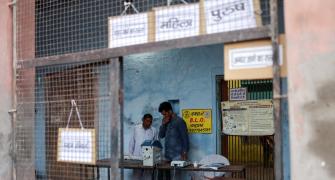After cricket, if there is anything that truly excites this nation, it is 'movies'. This film crazy nation has an insatiable appetite for movies with over 300 crore movie tickets sold in a year - the highest number of cinema admissions in the world.
With several positives to back them, multiplex operators are on a growth path. Booming consumerism fuelled by increased disposable incomes, changing lifestyle and attitude of people with changing demographics are providing the required impetus.
Several states too have announced entertainment tax exemptions for multiplexes in the initial years to drive growth. Thus, most multiplex stocks are quoting at fairly high valuations - price-earnings multiples are over 25 times FY07 earnings.
Considering the high fixed costs involved in operating multiplexes and the uncertainties relating to the performance of films in the box-office, which is the key driver of revenues, can these stocks hold their performance and rich valuations?
The answer is not easy. But analysts say that while the business will be vulnerable to hits and flops, the good news is that multiplex companies are trying to reduce the volatility in their revenue stream by increasing income from more steady sources.
Indeed, the exhibition business depends greatly on the quantity and quality of film releases. As per a FICCI report, around 30 per cent of the films generate 90 per cent of the industry revenues.
Also, there is a lot of seasonality in the business. But multiplexes have made attempts to reduce their dependence on 'hit' movies to generate revenues.
"There is no doubt that this business is seasonal and nothing can be done about that. One can only look at the optimisation of revenues on a weekly basis, says Shravan Shroff, managing director, Shringar Cinemas. Shringar optimises the weekend sales by tying up with banks, IT companies and other interested corporates, which buy out shows to push their trade and entertain clients.
"It serves us well to block inventory," adds Shroff. "In the past when there were not too many software we relied on screening one day cricket matches, plays, stand-up comedies, screening of black and white movies, regional movies, etc. In that sense we are not relying only on new releases to be able to define a season. For us a season is finally about providing enjoyment and leisure to our patrons," he says.
The expansion of genres of movies is also playing on their side. Movies are being made especially keeping the multiplex audience in mind.
Currently, on an average, multiplexes can break even at around 30-35 per cent occupancy levels and, currently, the average occupancy is 40-45 per cent. Of the various costs incurred by multiplexes, entertainment tax and payments to distributors are the major costs each taking away around 20 per cent of the revenues.
With most players operating on leased properties, lease rentals steal away a further 10 per cent of the turnover. The other costs include expenses incurred on food and beverages, employees, marketing and utilities like electricity, water, security, maintenance, IT, and telecom.
But such overheads are lower per screen since most of it is shared by multiple screens, and even locations. In any case, multiplexes enjoy better bargaining power with producers, distributors and F&B suppliers.
On the revenue side, multiplexes primarily have three sources of income - sale of tickets, advertisements and F&B. Around 67-77 per cent of the revenues come from tickets and that too 55-60 per cent of revenues are collected during weekends where typically occupancies are higher.
At present, around 20 per cent of the revenue comes from F&B. And multiplex operators are trying to increase their revenues from F&B as margins here are relatively higher - as high as 60-70 per cent.
Advertisement income, which includes on-screen and off-screen advertisements, is a relatively small source of income for multiplexes ranging between 6 per cent and 13 per cent of the total revenues.
Apart from efforts to increase revenues from this source, multiplexes are now resorting to hitherto untouched territories like in-theatre promotions, alternative contents like cricket matches, F1 races and corporate screenings.
Areas like elevators, ticket counters, ticket jackets, seats, floors, walls, popcorn containers and washrooms that were never used by traditional cinemas for advertising are being exploited now.
Another plus is that the multiplex model, with several screens with different seating capacities, itself lends greater flexibility to optimise revenues through dynamic pricing and scheduling of shows.
Ironically, what is actually perceived to be good news can also backfire for multiplexes. Firstly, all players have charted out very ambitious expansion plans and are spreading their wings aggressively. Consequently, competition is getting more intense.
Analysts fear that aggressive growth could lead to a supply glut soon, resulting in lower occupancy rates and a fierce price war. Income from advertising, which contributes around 10 per cent to total revenues, could also take a hit as companies might be forced to reduce their rates.
Similarly, the entertainment tax exemption that they enjoy on many of their properties is only for a specific period, which could eventually drag down profitability.
Secondly, as majority of the multiplexes are coming up in leased properties, they can expand at a faster rate with less capital requirement and break even faster.
But here again, the escalating realty prices could force higher rentals adding to fixed costs. As players may not be able to hike the price in the same proportion, margins could, to that extent, take a beating.
Another concern is the timeliness of execution of the ambitious plans. Majority of the multiplexes being set up are a part of malls, thus, much depends on the pace of mall development.
"The eventual winner is the one who executes better," says Kejal Mehta, an analyst from Karvy Broking. Of the projects that Shringar had committed during the initial public offering, only the Kolkata project is complete.
Even PVR's Juhu multiplex in sub-urban Mumbai was delayed and even the next one coming up at Mulund is facing some delay. "PVR's execution has been pretty good uptill now. These territories were new for PVR and, so, it was not fully aware of the nuances," says Mehta about the delays.
The story is the same for Inox and Adlabs too. As in March 2005, Adlabs operated 20 screens, which were to be scaled to 44 screens by March 2006.
However, now the target is pushed to be achieved by March 2007. The lack of progress is due to the delay in handover of the completed civic shell by the developer and delays in getting the necessary clearances from the government.
So, which stock should you bet on, if at all? Though Inox seems to be the most profitable among the four key multiplex stocks, analysts do not find it the most attractive as a stock. The market is more willing to bet on PVR and Shringar.
While PVR is a safe bet, Shringar is slotted in the 'high-risk-high-return' category. Even though Shringar has been making losses, it is expected to turn around in FY07.
"Exhibition is a modular business. Our growth happens by adding more multiplexes. The current loss is because of the fixed corporate overhead cost. As we keep adding more multiplexes, our profits would grow due to economies of scale," says Shroff.
What makes PVR special is that it has been profitable right since inception. PVR not only pioneered the multiplex concept but has also grown into the largest multiplex operator in the country, in terms of number of screens and is expanding further to establish a pan-India presence.
At present, PVR pays entertainment tax on most of its existing properties as it has strong presence in and around Delhi, where the tax is levied.
However, going forward, the company would save on entertainment tax because of its expansion in regions, which are exempted from entertainment tax.
This would mean faster breakeven in new properties apart from better overall profitability. At the current market price of Rs 225, the stock is trading at 25x its expected FY07 earnings of Rs 9 and at 11.72x its expected FY08 earnings of Rs 19.20.
Shringar Cinemas not only operates multiplexes under the Fame brand, but is also into distribution of movies. The company has an edge over its peers as its promoters have an experience of over 25 years in distributing movies, which helps them in gauging the likely commercial success of movies with higher degree of accuracy.
The company has recently decided to diversify by foraying into food courts beginning with the areas in which it has a multiplex and is slowly moving to other areas.
However, the growth driver for the company is expected to be the multiplex business. The company also intends to add two multiplexes, one each in Aurangabad and Surat under the theatre management model with 10 screens in H1 FY07.
Under this model, Shringar will offer its content selection and programming skills to the theatre owner for a fee and/or a share of profit.
Thus, this model allows Shringar to get a feel of the exhibition business, without having to incur heavy capital costs. The stock is trading at 23.12x its expected FY07 earnings of Rs 1.84 and 7.5x its expected FY08 earnings of Rs 5.67 at the current market price of Rs 42.55.
Inox is the most profitable player and has its multiplexes in premium locations across the country, which gives it pricing power.
Inox has one of the highest ticket prices per seat in the country and, yet, has one of the best occupancy rates in the industry. While the average ticket price for other players is Rs 120, for Inox it is Rs 175. Adlabs is an integrated entertainment company that runs its multiplexes under the Adlabs and Imax brands.
The company has its presence across various points of the value chain, from film processing, production, distribution to film exhibition. The exhibition business was responsible for just 22 per cent of FY06 revenues. Thus, in essence, Adlabs is not a pure multiplex player.







